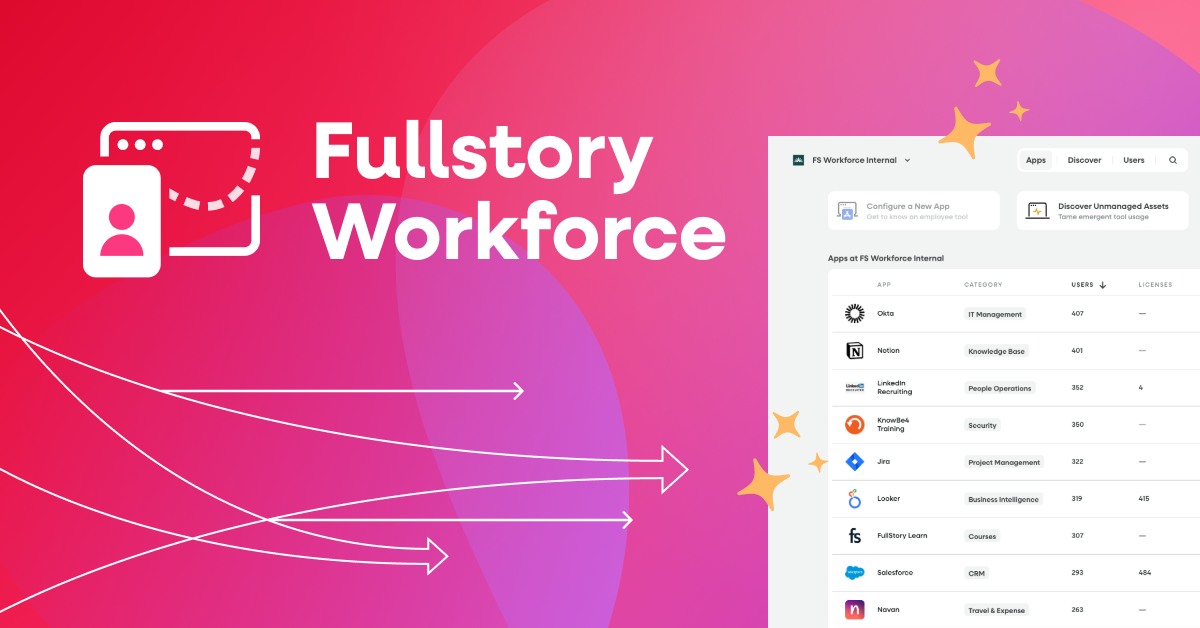Your ecommerce conversion funnel—that is, the path that visitors take to make a purchase—is perhaps the most important workflow on your site. Baymard Institute found that the average large-sized ecommerce site can increase overall conversion rate by over 35% by making critical improvements to the checkout flow. Clearly, finding and resolving any snags that are there should be a top priority for ecommerce pros.
While a best-in-class behavioral data platform like Fullstory proactively surfaces critical insights around the purchasing process, it’s up to you to take steps to get the most from your data–which means understanding how to build useful, scalable conversion funnels inside your analytics solution.
Here are some actionable tips for creating effective, optimized conversion funnels in your analytics tool.
The advantages of using Ecommerce conversion funnels
Your job is to keep your digital Ecommerce experience smooth, easy-to-navigate, and issue-free.
Building and analyzing conversion funnels can help you identify where users are hitting the biggest hiccups that are causing them to drop out of key workflows, like a dead button inside the checkout flow.
Additionally, funnel analysis can help you understand if page performance is an issue, or if problems impact certain segments of customers more than others (like those shopping on Chrome versus Safari).
Identifying issues like these through funnel analysis enables you to understand which issues are having the greatest effect on customer experience and then prioritize where your engineering team should focus their attention.
When Eommerce conversion funnels are useful for improving your checkout experience
When should you turn to funnel analytics to uncover an opportunity in your Ecommerce digital experience? Here are a few examples:
Identifying “unknown unknowns”
Often, when looking for flaws in your Ecommerce experience, it can be difficult to know where to begin. Building a broad funnel for the most vital workflows on your site—the steps in your checkout flow, in particular—gives you a starting point from which to find more granular improvements.
Testing a hypothesis
Perhaps you’ve been poking around in a retail and ecommerce analytics platform and you’ve come up with an idea for a way to improve a page on your site. For example, you’ve hypothesized that adding a checkbox where users can say “shipping address is the same as billing address” will get 5% more shoppers to the next stage of checkout. You can test this change on a segment of users, and then compare how they flow through the funnel versus those who don’t see the checkbox.
Measuring negative impact
Conversion funnels are most useful for helping you understand which elements of your site are having the most negative impact on the customer experience, rather than elements that might be having a positive effect. For example, Fullstory customer Moosejaw conducted an audit of their checkout funnel and found that a seemingly minor error—how address verification messages were displayed—was having an outsized negative impact on conversions.
Best practices for building effective conversion funnels
Your conversion funnels are a powerful tool for improving your Ecommerce experience and conversion rate optimization. There are a few simple steps you can take to ensure they're highly effective. Here are five best practices for getting the most out of your conversion funnels:
Conversion funnels need at least two events, but including four to six events in your funnel will ensure that it provides a clear, thorough look at how users move through the series of steps.
Make sure the first step in your funnel isn’t too broad. Users can fall out of a funnel at any time–even after the first step–so you want it to be narrow enough to find meaningful user data. For example, “Visited my homepage URL,” might be too broad to be a useful first step in your funnel, but “Visited the URL containing /summer-styles” is a happy medium.
If you notice an exceptionally large drop-off between two steps in your funnel (like between “Clicked ‘Add to cart’” and “Viewed cart”), consider breaking your funnel into two separate funnels to get a more granular view of what might be causing a dramatic drop-off rate.
Choose a date range for your funnel that’s appropriate to what you want to measure. For example, if you want to see the impact resulting from a change you implemented recently, set the date range to “This past week.”
Try narrowing your funnel analysis to a single attribute to understand how different cohorts of users might be experiencing your site. For example, look at mobile shoppers versus desktop shoppers, or those browsing on Chrome versus those browsing on Safari, to see if there are any notable trends.
For more tips on building effective funnels, check out this blog post on using funnels to understand user behavior. →
How Fullstory takes conversion funnels to the next level with Conversions and Revenue Opportunities
Many analytics solutions offer the ability to build and analyze conversion funnels, but Fullstory enables Ecommerce pros to go beyond traditional funnel analysis with two powerful funnel enhancements: Conversions and Revenue Opportunities.
Built by our team of data science experts, Fullstory Conversions uses machine learning to analyze different cohorts of users as they pass through your key funnels. By showing exactly when, where, and why users are dropping out of those funnels, Conversions enables digital Ecommerce teams to prioritize issues based on business impact.
Plus, Revenue Opportunities allows users to define and select Revenue Events that represent specific business transactions, and correlate the projected annualized revenue lost to specific issues in your funnel.
Knowing how much revenue is associated with a particular issue enables Ecommerce teams to intelligently and confidently prioritize issues in order of business impact.
To learn more about making high-impact user experience improvements with Fullstory, talk to one of our experts.




